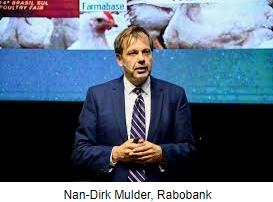In a recent review of World egg supply, prices and trends, Nan-Dirk Mulder, Senior Analyst, at Rabobank considered the extent and causation of price volatility in eggs. Mulder noted that during the past year, egg prices have exceeded the FAO Food Price Index. The expectation is for prices to remain high through the remainder of 2023 but at a lower level than the peaks recorded during the first quarter of the year.
 The Rabobank report did not address the precipitous decline in egg prices in the U.S. as the market entered the second quarter of this year. The decline cannot be attributed to a rise in supply since hen numbers have not increased by more than ten million from a constant deficit of approximately twenty million hens or about seven percent of the pre-HPAI population. Losses occurred as a result of a second wave of avian influenza during the fall of 2022, ending in December. An increase of approximately ten million hens in the producing flock should not have depressed wholesale prices from $4 to less than $1 over a five-week period. Despite the accepted price elasticity of eggs, it is evident that other factors including the distorting effect of the prevailing price discovery system, amplifying peaks and troughs may have played a role.
The Rabobank report did not address the precipitous decline in egg prices in the U.S. as the market entered the second quarter of this year. The decline cannot be attributed to a rise in supply since hen numbers have not increased by more than ten million from a constant deficit of approximately twenty million hens or about seven percent of the pre-HPAI population. Losses occurred as a result of a second wave of avian influenza during the fall of 2022, ending in December. An increase of approximately ten million hens in the producing flock should not have depressed wholesale prices from $4 to less than $1 over a five-week period. Despite the accepted price elasticity of eggs, it is evident that other factors including the distorting effect of the prevailing price discovery system, amplifying peaks and troughs may have played a role.
On a world basis, Mulder is correct in attributing price volatility to factors other than those currently influencing the U. S. market: -
- He attributes higher feed and other input costs including labor and energy as being responsible. Generally, cost of production and the retail price are not directly connected. Price is a function of demand in relation to supply. He is correct in noting that the viability of small-scale producers in emerging markets has deteriorated but this would not have had more than a local effect.
- Supply was severely constrained in many E.U. nations and in North America by the H5N1 panornitic in 2022 with prospects of resurgence in the fall. Although 44 million hens were depleted in the U. S., outbreaks occurred in two waves and in effect, approximately 20 million hens or approximately seven percent of the population were not producing on a constant basis during the year. Japan was severely affected with the loss of 17 million hens representing nine percent of the laying flock and in South Africa with a loss of close to three million hens, supply was lowered by ten percent.
 It remains to be seen whether outbreaks in Latin America will severely impact supply including the potential to devastate areas of high-density egg production in Brazil.
It remains to be seen whether outbreaks in Latin America will severely impact supply including the potential to devastate areas of high-density egg production in Brazil.
- Demand increased in 2022 as a result of lifting COVID restrictions with a consequential increase in demand by the food service sector.
- Inflation has raised the price to consumers of all animal proteins. There has been evident substitution of red meat by chicken and an increase in demand for eggs that represent value especially for in-home meals among lower economic demographics.
- Rabobank attributes a ban on the culling of cockerels for producing shortages in Western Europe. Apparently, the producing flock in Germany has dropped by 20 percent and this nation will evidently be obliged to import more eggs. Local factors such as the banning of conventional cages in New Zealand has disrupted supply resulting in a 10 to 15 percent deficit in the national flock. Government intervention placing ceiling prices on eggs in some nations has contributed to volatility. This strategy is invariably ineffective since small-scale farmers reduce their production as they are unable to generate positive margins in the face of increased costs. Government intervention placing a ceiling price on eggs and other foods converts a low-price policy into a no-food situation The opposite occurs when subsidies are provided resulting in an over-supply in the intermediate term generating volatility.
The conclusion of the Rabobank report is that prices will follow a cyclic pattern as flocks are replaced. In some cases, large flocks that produce in excess of demand can create market distortions as happened in the U.S. during 2016 following recovery from HPAI.
Mulder correctly indicates that the unknown factor in future egg prices will be the incidence rate of avian influenza. This is a function of a series of H5Nx viruses persisting and undergoing drifts and shifts in migratory and marine wild-bird populations. Stability in prices will only be achieved with control of HPAI through deployment of an effective and extensive program of immunization as an adjunct to biosecurity.